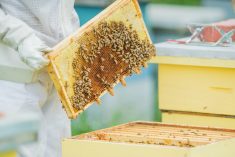Reuters — A U.S. appeals court ruled on Thursday that federal regulators erred in allowing an insecticide developed by Dow AgroSciences onto the market, canceling its approval and giving environmentalists a major victory.
The ruling by the U.S. Court of Appeals for the Ninth Circuit, in San Francisco, is significant for commercial beekeepers and others who say a dramatic decline in bee colonies needed to pollinate key food crops is tied to widespread use of a class of insecticides known as neonicotinoids. Critics say the Environmental Protection Agency is failing to evaluate the risks thoroughly.
Read Also

BASF cuts 2025 outlook as tariffs weigh on global economy
Germany’s BASF said on Friday that it was lowering its full-year outlook, citing weaker-than-expected global economic growth and reduced demand for its chemicals due to U.S. tariffs.
The lawsuit was filed in 2013 against the EPA by organizations representing the honey and honey beekeeping industry. The groups specifically challenged EPA approval of insecticides containing sulfoxaflor, saying studies have shown they are highly toxic to honey bees.
Dow AgroSciences first sought EPA approval for sulfoxaflor in 2010 for use in three products. Brand names include Transform and Closer.
“It’s a complete victory for the beekeepers we represent,” said Greg Loarie, an attorney who represents the American Honey Producers Association, the American Beekeeping Federation and other plaintiffs in the case. “The EPA has not been very vigilant.”
Dow said in a statement that it “respectfully disagrees” with ruling and will “work with EPA to implement the order and to promptly complete additional regulatory work to support the registration of the products.”
The EPA said it was reviewing the court’s decision and would have no further comment.
California’s Department of Pesticide Regulation issued a statement Thursday noting that it has long had concerns about sulfoxaflor’s impact on bees and has never allowed unconditional registration in that key farming state.
Honeybees pollinate plants that produce roughly a quarter of the food consumed by Americans. The demise of the bees has become a hotly debated topic between agrichemical companies, which say the insecticides they sell are not to blame, and those who say research shows a direct connection between neonicotinoids and large bee die-offs.
The White House has formed a task force to study the issue and the EPA has said it is trying to address concerns.
In its ruling, the court found that the EPA relied on “flawed and limited data” to approve the unconditional registration of sulfoxaflor, and that approval was not supported by “substantial evidence.”
Dow had asked the EPA to approve sulfoxaflor for use on a variety of crops, including citrus, cotton, canola, strawberries, soybeans and wheat.
The EPA analyzed studies and data provided by Dow about the effects of sulfoxaflor on various species, including bees, and initially proposed several conditions on approval due to insufficient data provided by Dow, the court found.
However, in May 2013 the EPA decided to go ahead with unconditional registration even though the record revealed Dow never completed additional requested studies, the ruling stated.
In vacating the EPA approval, the court said that “given the precariousness of bee populations, leaving the EPA’s registration of sulfoxaflor in place risks more potential environmental harm than vacating it.”
The EPA must obtain further data regarding the effects of sulfoxaflor on bees as required by EPA regulations before it grants approval, the court said.
The U.S. Department of Agriculture said earlier this year that losses of managed honeybee colonies hit 42.1 per cent from April 2014 through April 2015, up from 34.2 per cent for 2013-14, and the second-highest annual loss to date.
In Canada, Dow picked up full federal registration in June this year for sulfoxaflor as an active ingredient in Closer, Transform, Twinguard and Isoclast insecticides.
According to Health Canada, sulfoxaflor is a nicotinic acetylcholine receptor agonist, like neonicotinoids, but has a different mode of action, which puts it in the sulfoximine class.
In its registration decision, Health Canada’s Pest Management Regulatory Agency said that while sulfoxaflor is “unlikely to pose a risk to bee colonies, it may pose a potential risk to adult foraging bees exposed directly to spray droplets or to fresh residues on plants.”
Those effects, PMRA said, “are relatively short-lived, lasting approximately three days or less. When the risk reduction measures included on the label are followed, risks to bees are considered to be acceptable.”
— Carey Gillam is a Reuters correspondent covering agribusiness from Kansas City. Includes files from AGCanada.com Network staff.
















